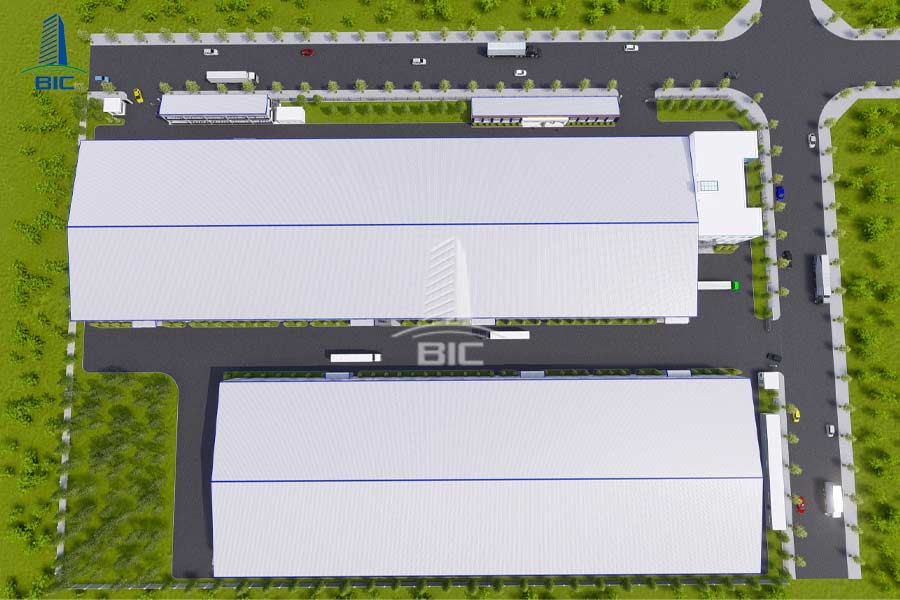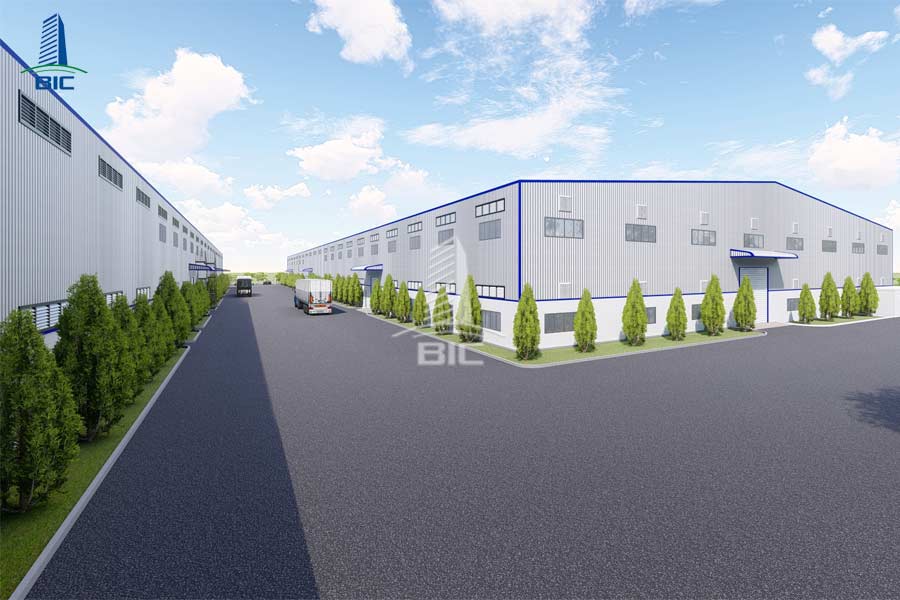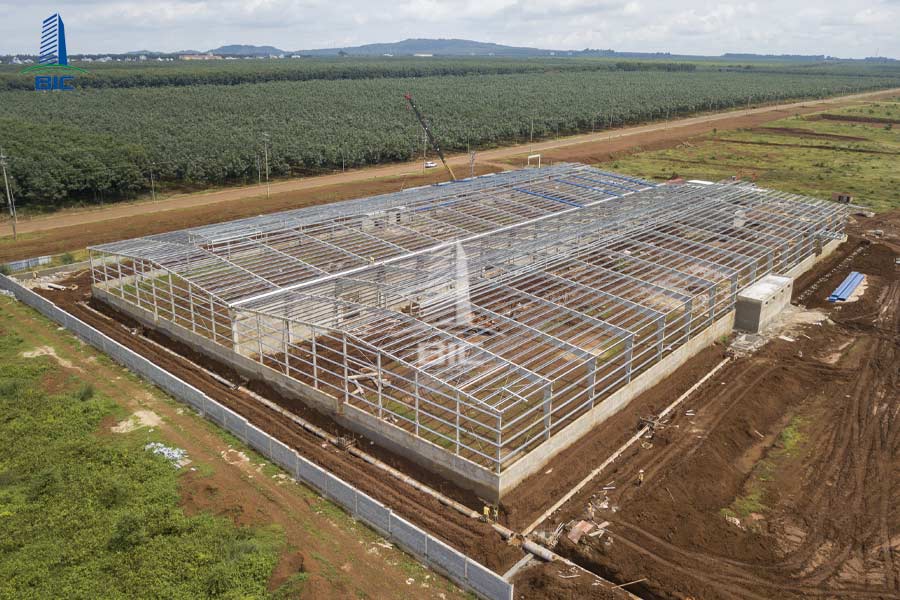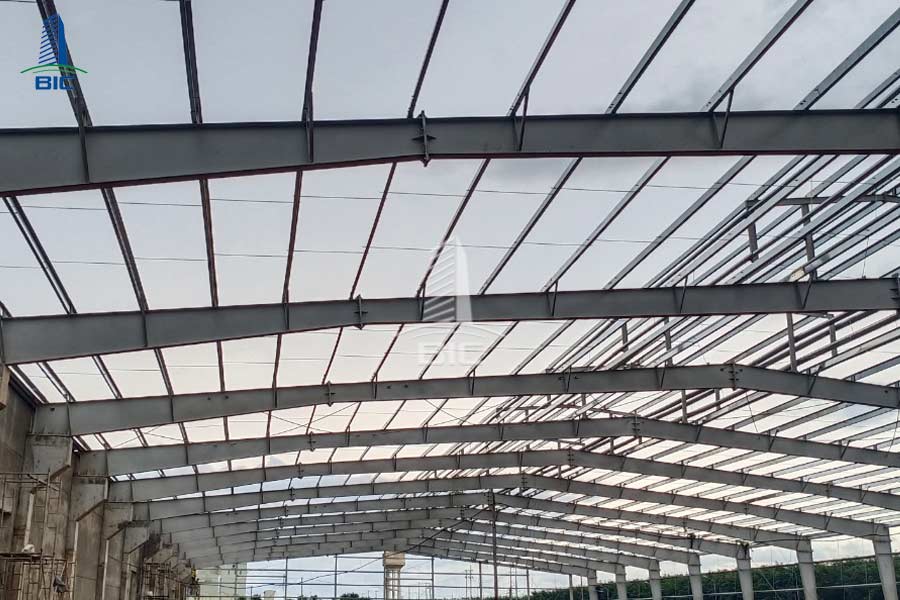
The rapid growth of the industrial and logistics sectors has driven the demand for a wide variety of industrial factory types. Depending on their intended use, production characteristics, and investment budget, each type of factory has its own structural design, materials, and construction solutions. Understanding these types and their differences will help investors make the right decisions from the very beginning of the factory design and construction process.
Choosing the right factory type not only affects the functionality and lifespan of the building but also optimizes investment costs, ensures construction progress, and allows for future expansion. In this article, BIC introduces the most common types of industrial factories today, analyzing their advantages and disadvantages, and providing clear distinctions to help businesses select the most suitable model for their production needs.
Characteristics:
These factories use a fully prefabricated steel frame system manufactured in a factory, including columns, trusses, purlins, bracing systems, and bolted connections. When designing this type, engineers precisely calculate loads, component dimensions, and installation positions so that assembly on-site is quick and accurate.
Materials: High-strength steel with anti-corrosion treatment (galvanized or powder-coated), insulated metal roofing, and insulated sandwich panels for walls.
Advantages:
- Fast construction: 30–50% shorter than reinforced concrete, allowing quicker operation.
- Flexible: Can be dismantled, expanded, or relocated when needed.
- Optimized foundation cost: Lightweight structure reduces load on the foundation.
Disadvantages:
- Requires periodic maintenance of protective coatings to prevent rust.
- Insulation and soundproofing depend on cladding materials.
Applications: Garment manufacturing, warehousing, logistics, food processing, light mechanical assembly.

Characteristics:
The main structure uses reinforced concrete columns, beams, and slabs either cast-in-place or precast capable of withstanding heavy loads and offering durability against mechanical and weather impacts. This type is common in designs requiring high strength and long-term stability.
Materials: High-quality cement, standard rebar, waterproofing and anti-crack additives.
Advantages:
- Long lifespan, up to 50–70 years.
- High load capacity, fire resistance, soundproofing, and thermal insulation.
- Requires less maintenance compared to steel.
Disadvantages:
- Longer construction time due to concrete pouring and curing.
- Difficult to renovate or expand because of its monolithic structure.
Applications: Heavy industry, chemical manufacturing, woodworking, large-scale mechanical engineering.

Characteristics:
Uses concrete for foundations, floors, and exterior walls, combined with a steel frame for roofing and main spans. In factory design, this is a balanced solution between durability and construction speed.
Materials: Load-bearing reinforced concrete, galvanized or anti-rust painted steel frames, insulated metal roofing.
Advantages:
- Combines the strengths of both concrete and steel structures.
- Faster construction than full concrete.
- Strong, stable structure suitable for various production types.
Disadvantages:
- Higher initial investment compared to some alternatives.
- Requires skilled workers experienced in both steel and concrete construction.
Applications: Mechanical factories, electronics component manufacturing, high-standard food processing.
Characteristics:
Designed with two or more floors, suitable for areas with limited land but high production or storage demand. Engineers must calculate inter-floor loads, material handling systems, and structural safety solutions.
Materials: May be fully reinforced concrete or a steel–concrete combination.
Advantages:
- Maximizes usable space on limited land.
- Easy to divide functions by floor.
Disadvantages:
- High investment cost, complex engineering requirements.
- Requires dedicated material handling systems such as industrial elevators and conveyors.
Applications: High-tech manufacturing, electronics, urban storage facilities, precision mechanical workshops.

Below is a comparison table that clearly distinguishes common types of industrial factories, including their characteristics, advantages, disadvantages, and applications. This table is designed to help you easily identify and choose the most suitable type when designing or constructing a factory.
|
Factory Type |
Structure & Materials |
Advantages |
Disadvantages |
Suitable Applications |
|
Pre-Engineered Steel |
Prefabricated steel frame, galvanized/painted, insulated metal roofing or panels. |
- Fast construction (30–50% faster) - Flexible for expansion/moving - Reduces foundation load, saving costs |
- Requires periodic anti-rust maintenance - Insulation/soundproofing depends on cladding |
Garment, warehousing, logistics, food processing, light mechanics |
|
Reinforced Concrete |
Cast-in-place or precast concrete columns, beams, slabs. |
- Long lifespan (50–70 years) - Strong, fireproof, insulated, low maintenance |
- Long construction time - Hard to expand/renovate |
Heavy industry, chemicals, woodworking, large-scale mechanics |
|
Hybrid (Concrete+Steel) |
Concrete foundations/floors/walls + steel roofing/spans. |
- Combines benefits of both - Faster than full concrete - Strong, stable |
- Higher initial cost - Complex construction requirements |
Mechanics, electronics, high-standard food processing |
|
Multi-Story |
2+ floors, reinforced concrete or steel–concrete hybrid. |
- Maximizes land use - Easy zoning |
- High cost - Requires dedicated goods handling systems |
High-tech, electronics, urban warehousing, precision mechanics |
- Light industries like garment manufacturing and electronics assembly often prefer pre-engineered steel for quick construction and expansion flexibility.
- Heavy industry, chemicals, and woodworking usually require reinforced concrete for high load-bearing and fire resistance.
- Industries needing both durability and fast construction such as precision engineering or high-standard food processing can opt for hybrid factories.
- Limited budget, quick operation needed: Choose pre-engineered steel.
- Higher budget, focus on long-term durability and safety: Choose reinforced concrete or hybrid.

- Large land area: Single-story factories to optimize horizontal production flow.
- Limited or high-cost land: Multi-story factories to increase usable space.
- Food and pharmaceutical industries: Must meet GMP, HACCP standards with dust and pest control solutions.
- High fire-risk industries: Must have certified fire prevention systems, heat-resistant structures, and proper escape routes.
- Projects needing quick market entry: Pre-engineered steel or hybrid structures to shorten construction time.
- Long-term projects with stable functions: Invest in reinforced concrete for lasting durability.
Choosing the right type of industrial factory impacts production efficiency, investment costs, expansion capability, and building lifespan. Understanding the characteristics, pros and cons, and applications of each type helps businesses make accurate decisions right from the design stage.
Whether you opt for pre-engineered steel, reinforced concrete, hybrid, or multi-story factories, each model requires careful consideration of structure, materials, functionality, and technical standards. A well-planned investment strategy from the start ensures optimized timelines, reduced operating costs, and improved long-term business performance.
If you are looking for the most suitable design and construction solution for your production needs, our team of engineers is ready to assist you from surveying and consultation to full turnkey construction. Contact BIC today for a free consultation, optimal design, and detailed quotation, we guarantee quality, on-time delivery, reasonable costs, and full legal support.